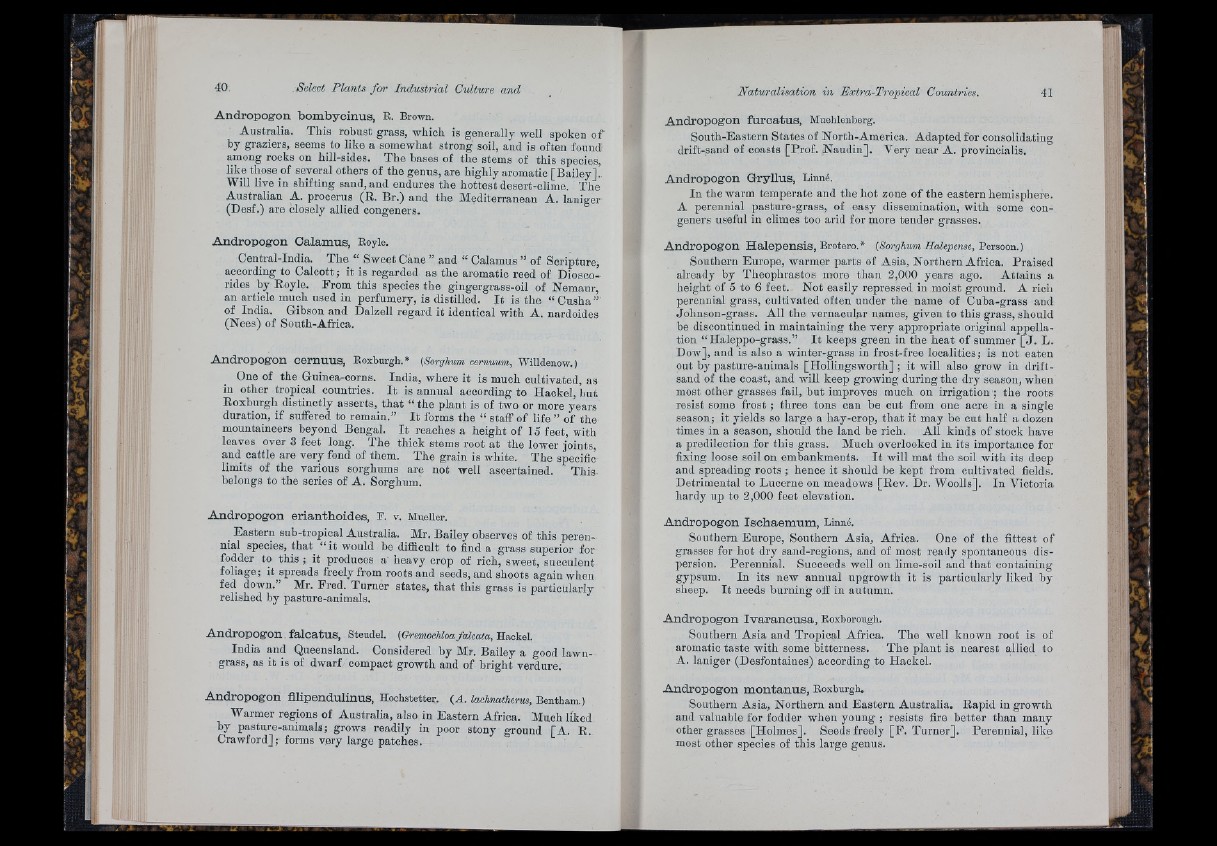
A n d ro p o g o n b om b y c in u s , R. Brown.
Australia. This robust grass, which is generally well spoken o f
by graziers, seems to like a somewhat strong soil, and is often found
among rocks on hill-sides. The bases of the stems of this species,
like those of several others of the genus, are highly aromatic [Bailey]..
Will live in shifting sand, and endures the hottest desert-clime. The
Australian A. procerus (JR. Br.) and the Mediterranean A. laniger
(Desf.) are closely allied congeners.
A n d ro p o g o n C a lam u s, Royle.
Central-India. The “ Sweet Cane ” and “ Calamus ” of Scripture,
according to Calcott; it is regarded as the aromatic reed of Dioscorides
by Koyle. Prom this species the gingergrass-oil of Nemaur,
an article much used in perfumery, is distilled. I t is the “ Cusha ”
of India. Gibson and Dalzell regard it identical with A. nardoides
(Nees) of South-Africa.
A n d ro p o g o n c e rn u u s , Roxburgh.* (Sorghum cemuum, Willdenow.)
Cne of the Guinea-corns. India, where it is much cultivated, as
in other tropical countries. I t is annual according to Hackel, but
Roxburgh distinctly asserts, th a t “ the plant is of two or more years
duration, if suffered to remain.” I t forms the “ staff of life ” of the
mountaineers beyond Bengal. I t reaches a height of 15 feet, with
leaves over 3 feet long. The thick stems root a t the lower Joints,
and cattle are very fond of them. The grain is white. The specific
limits of the various sorghums are not well ascertained. This
belongs to the series of A. Sorghum.
A n d ro p o g o n e ria n th o id e s , P. v. Mueller.
_ Eastern sub-tropical Australia. Mr. Bailey observes of this perennial
species, that “ it would be difficult to find a grass superior for
fodder to this ; it produces a heavy crop of rich, sweet, succulent
foliage; it spreads freely from roots and seeds, and shoots again when
fed. down.” Mr. Fred. Turner states, that this grass is particularly
relished by pasture-animals.
A n d ro p o g o n fa lc a tu s , Steudel. (Gremoehloa falcata, Hackel.
India and Queensland. Considered by Mr. Bailey a good lawn-
grass, as it is of dwarf compact growth and of bright verdure.
A n d ro p o g o n filip e n d u lin u s, Hochstetter. (A . lachnatherus, Bentham.)
Warmer regions of Australia, also in Eastern Africa. Much liked
by pasture-animals; grows readily in poor stony ground [A. R.
Crawford]; forms very large patches.
A n d ro p o g o n fu r c a tu s , Muehlenberg.
South-Eastern States of North-America. Adapted for consolidating
drift-sand of coasts [Prof. Naudin]. Very near A. provincialis.
A n d ro p o g o n G ry llu s, Linné.
In the warm temperate and the hot zone of the eastern hemisphere.
A perennial pasture-grass, of easy dissemination, with some congeners
useful in climes too arid for more tender grasses.
A n d ro p o g o n H a le p e n s is , Brotero.* (Sorghum Halepense, VerBOon.)
Southern Europe, warmer parts of Asia, Northern Africa, Praised
already by Theophrastos more than 2,000 years ago. Attains a
height of 5 to 6 feet. Not easily repressed in moist ground. A rich
perennial grass, cultivated often under the name of Cuba-grass and
Johnson-grass. All the vernacular names, given to this grass, should
be discontinued in maintaining the very appropriate original appellation
“ Haleppo-grass.” I t keeps green in the heat of summer [ J . L.
Dow], and is also a winter-grass in frost-free localities; is not eaten
out by pasture-animals [Hollingsworth]; it will also grow in drift-
sand of the coast, and will keep growing during the dry season, when
most other grasses fail, but improves much on irrigation ; the roots
resist some frost ; three tons can be cut from one acre in a single
season; it yields so large a hay-crop, th a t it may be cut half a dozen
times in a season, should the land be rich. All kinds of stock have
a predilection for this grass. Much overlooked in its importance for
fixing loose soil on embankments. I t will mat the soil with its deep
and spreading roots ; hence it should be kept from cultivated fields.
Detrimental to Lucerne on meadows [Rev. Dr. Woolls]. In Victoria
hardy up to 2,000 feet elevation.
A n d ro p o g o n Iso h a em u n i, Linné.
Southern Europe, Southern Asia, Africa. One of the fittest of
grasses for hot dry sand-regions, and of most ready spontaneous dispersion.
Perennial. Succeeds well on lime-soil and th a t containing
gypsum. In its new annual upgrowth it is particularly liked by
sheep. I t needs burning off in autumn.
A n d ro p o g o n Iv a r a n c u s a , Roxborough.
Southern Asia and Tropical Africa. The well known root is of
aromatic taste with some bitterness. The plant is nearest allied to
A. laniger (Desfontaines) according to Hackel.
A n d ro p o g o n m o n ta n u s , Roxburgh.
Southern Asia, Northern and Eastern Australia. Rapid in growth
aud valuable for fodder when young ; resists fire better than many
other grasses [Holmes]. Seeds freely [P . Turner]. Perennial, like
most other species of t lis large genus.